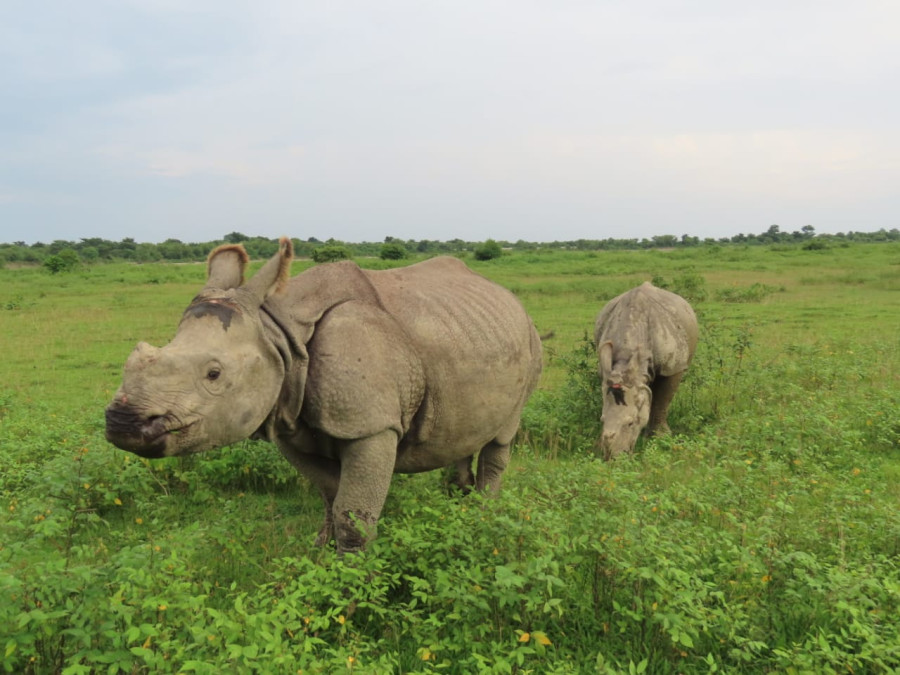Koshi Province
Translocated rhinos thriving in their adopted home
Two Chitwan rhinos—four-year-old Pushpa and three-year-old Anjali—were translocated to the Koshi Tappu Wildlife Reserve in September.
Binod Bhandari
Pushpa and Anjali—the translocated female rhinos from Chitwan National Park—have been enjoying their new habitat in Koshi Tappu Wildlife Reserve.
Every day four-year-old Pushpa and three-year-old Anjali come out of their cages in the Pathari sector at 6 am and graze in the grasslands along with the reserve’s elephant all day before returning to their enclosures in the evening. The reserve employees have managed grass feed for the pachyderms in the enclosure too.
Pushpa and Anjali were relocated to Koshi Tappu Wildlife Reserve, the major habitat of wild water buffaloes (Arna in Nepali), on September 27. The Federal Ministry of Environment, based on the recommendations of conservationists and technicians, granted permission for the translocation of six rhinos from the Chitwan National Park.
“Pushpa and Anjali have adjusted well to their new environment. They haven’t shown any abnormal activities as of now,” said Birendra Gautam, Koshi Conservation Centre chief of the National Trust for Nature Conservation (NTNC). According to him, around two hectares of forest land near Pathari Wildlife Rescue Centre in Saptari district has been allocated as pasture for the two rhinos.
“The pasture has been fenced to avoid the intrusion of other animals,” Gautam said. An artificial pond has also been constructed in the grassland. According to conservationists, Pushpa and Anjali often go to the nearby Triyuga River to drink water and play in the mud.
In 2017, sixteen water buffaloes had been translocated to Chitwan from Koshi Tappu Wildlife Reserve despite protests from the locals. They were housed in a 30-hectare enclosure at a grassland in Padampur. All the shifted bovines died within five years due to the constant floods and tiger attacks.
Conservationists are optimistic regarding the successful translocation of rhinos in Koshi Tappu Wildlife Reserve. They argue that the reserve has a favourable climate for the pachyderms and there are no hunting animals like tigers and leopards in the reserve’s forests.
“The translocated rhinos are now in good condition. The pastureland is made safe for them. Koshi Tappu Wildlife Reserve is becoming a suitable habitat for rhinos,” said Gautam.
Pushpa and Anjali were both rescued in Chitwan at different times. Pushpa was rescued as a two-year-old separated from her mother. Anjali was only one month old when she was rescued. Both of them have grown up under human supervision in Chitwan before being released into their natural habitat in May this year.
The employees of the reserve, the NTNC, and tamed elephants have been mobilised to look after Pushpa and Anjali. The security personnel of the Durgadal Battalion of Nepal Army posted for the reserve’s security also support the adaptation of the shifted rhinos.
Ramesh Kumar Yadav, chief at the reserve, said that efforts are on to shift a male rhino soon. A female rhino generally seeks a partner for mating after four years of age. The conservationists hope there will be breeding opportunities for female rhinos if male rhinos are introduced into the habitat.
“Necessary preparations are on to bring a male rhino. However, we have immediate concerns for Anjali since the male rhino can attack her since she is still young,” said Yadav.
According to Yadav, a feasibility study regarding the translocation of tigers to the wildlife reserve is also underway. Federal Minister for Forest and Environment Birendra Prasad Yadav raised the issue of tiger relocation in Koshi Tappu Wildlife Reserve during the relocation programme of Pushpa and Anjali some three months ago.
The reserve spread over an area of 176 sq km in Sunsari, Saptari and Udayapur districts was established in 1976. As per the latest census conducted in 2021, there are a total of 498 water buffaloes in the reserve. It is also home to 20 other animal species including hog deer, wild boar, spotted deer, blue bull, rock python and 441 bird species.




 19.12°C Kathmandu
19.12°C Kathmandu















